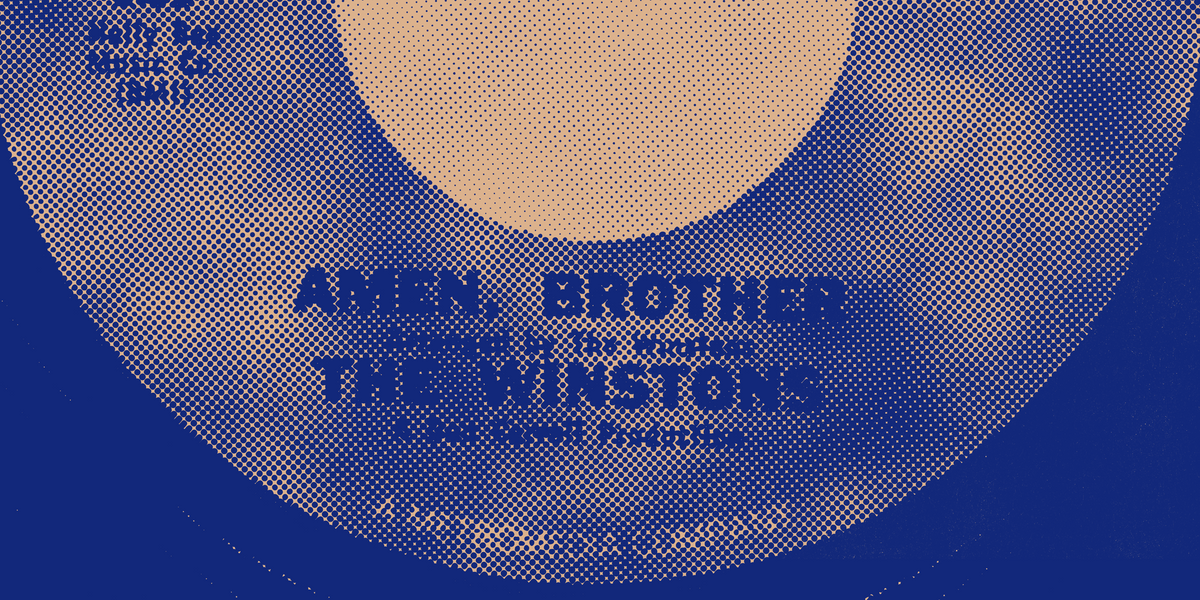The ultimate guide to 50 years of the Amen Break
The most famous drum sample of all time has turned 50 years old. Let's look at the history of the Amen Break from The Winstons.

The most famous drum sample of all time has turned 50 years old. In that time the Amen Break has become an indistinguishable part of modern culture. So much so that somewhere in the world, right now, that six second drum loop is playing in music, on television commercials, in film soundtracks and no shortage of documentaries or drumming tutorials. Not bad for the improvised afterthought in a regional band’s recording session already running overtime.
Rewinding the story of the Amen Break
The Winstons were a funk and soul band recording what would become their Grammy Award winning single Colour Him Father. In a wonderful moment of reminiscing with the BBC, Richard Spencer, the band’s lead singer and sax player, recalls that very session.
Spencer paints the scene as a band filling out their remaining studio time to largely improvise the flip-side to a 7-inch single. They settle on an instrumental version of a traditional Baptist hymnal and according to Spencer, “in about 20 minutes, we had a playable song”. And right in the middle of that song? A syncopated break played by a drummer laid back in the pocket and laying down the sound of entire genres in the decades to come.
And the unwitting soundtrack to the band’s own mix of tragedy and delayed dues, a story all too common when considering the heritage of Black music culture in America. So often reshaping the world around it while somehow overlooking the participation (and remuneration) of those that contributed in its making.
Give the drummer some
Gregory “G.C.” Coleman’s name may be recognised by crate diggers and funk drummers, but he was no stranger to the R&B music scene at the peak of the 1960s. He had a career spanning his own act, GC Coleman and the Soul Twisters, drumming for the Marvelettes, and playing in both Otis Redding and Curtis Mayfield’s bands. A distinguished career even before moving to Washington to form what would later become The Winstons. Not to mention his later session drumming on projects like The Burning of Atlanta.
Coleman’s story isn’t uncommon for the era, and perhaps for musicians at any period in time, a mixture of success (including a Grammy for best R&B song) and a sad ending — reported to have passed away in 2006 suffering from addition and homelessness. Not a lot has been shared about Coleman’s later years by surviving family and friends, nor does his discography seem fully documented, but we gain adjacent glimpses into the nature of the music industry for similar artists through documentaries such as Standing in the Shadows of Motown(stream it here), a 2002 exploration of the session musicians behind many of the legendary Motown hits. It’s a useful starting point if only as a reminder that it takes passionate fans to dig through the years, and the liner notes, of records largely still tucked away in shelves and boxes, unearthing the stories of the humans in and around the culture that has made possible all that followed.
One of those kinds of fans is Joseph Speight, also known as DJ Proto J, who is filming a documentary on the history and wider impact of the Amen Break. In a quick exchange while researching this article, Speight revealed that he has been putting in the miles to get a solid cross section of interviews for the project so far.
“I’ve already interviewed Goldie, Andy C, Bukem, Dillinja, QuestLove, D-Bridge, Paradox, Equinox, Fracture, Breakbeat Lou, Frankie Bones, OG members of the band, the engineer who recorded it, and many more,” he said. And confirming that there “should be a trailer out this [US] summer”.
This is quite the cross section of cultural relevance, including Alan Leeds, not only former tour manager for James Brown (and author of the excellent memoir “There was a time”), but personal friend of Coleman’s. Speight’s research in interviewing so widely and so deeply goes beyond the typical coverage, and also looks to cover some potentially difficult conversations in and around the band’s inter-personal relationships. A part of the story that hasn’t been known as the world has increasingly taken an interest in the genesis of cultural icons like the Amen Break.
The evolution of the Amen Break story
These stories are never static. Even the original artists themselves may shift in their commentary of whatever the current industry has evolved into. This is something Spencer himself has experienced as the shock of the Amen Break’s copyright infringing ubiquity faded (or perhaps blossomed) into an understanding of the sheer scale of usage. Spencer told the BBC in 2015 that he originally saw the situation as “like plagiarism” and feeling “ripped off”, which is more than understandable imagining one turning on a radio in the late 80s (let alone 90s) and hearing that familiar beat.
In recent years we perhaps see these six seconds of drums a little differently, but so does Spencer. “It’s not the worst thing that can happen to you,” he said. “I’m a Black man in America and the fact that someone wants to use something I created — that’s flattering.”
For those of us immersed in culture, creation, and mindful of history, it’s more than an understatement that the Black population in America is due more than just flattery for influencing nearly all modern genres of music, from Blues to Rock to House to Hiphop and beyond. Knowing where and how to pay dues decades beyond the fact is a difficult things. And in this case the most recent effort came from a surprisingly common place for Black music appreciation. The United Kingdom.
And now for some good news
In 2015, Martyn Webster, a former UK DJ and fan of the Amen Break, set up a crowdfunding campaign that resulted in more than £24,000 being raised. His story on the original Gofundme page is worth a read, as is the linked interviewbetween Spencer and BBC Radio One’s Kutski.
For those of us coming to the campaign late, Webster has gone on to create a second campaign that is able to remain open and is controlled by Spencer himself. While Coleman may have sadly passed, the fundraising effort created an opportunity to pay some respect (and pay some dues) for the band, the break, and the impact it has had worldwide.
According to Speight’s research for his documentary movie, there is some tension around the distribution of the funds raised (especially pertaining to Coleman’s surviving family), and suggestions that band members were not all pleased with the ownership of the music’s copyright throughout their career. These are no doubt issues that will be explored in the documentary, and something that many of us who have had music careers will know are often more nuanced than neatly fits in the current era of hot takes (or “hot tweets” as the current news cycle goes).
As well as being an evolving story for the breaks-loving public, it seems to be an evolving reaction from the band members themselves. Spencer’s note posted to the updates section of the fundraising page reading a long way away from his frustration in earlier years.
“Special thanks to Martyn Webster and his associates, as well as all of the friends of this significantly beautiful piece of orchestration called ‘The Amen Breakbeat Gesture’,” he said. “You have made a very loving statement through the ‘GoFundMe’ event that I will cherish forever. Thanks for your psychological and monetary contributions.”
This is very much different to the view of the world Spencer had in 2008, when writer Desmond Williams spoke with him for an excellent piece for Verbicide magazine. Responding to a line of questioning including references to the Golden Ratio as the almost divine inspiration for the break’s popularity, Spencer cut the academic pondering back to harsh reality for a Black musician of that era.
“It’s almost insulting to try and attach ideological and philosophical bullshit connotations,” Spencer said. “I think towards the end, Greg did realise its popularity, but who’s benefiting? Certainly not Greg.”
It’s without question an appreciation of modern connected culture that at least the surviving talent responsible can get paid their dues from the global massive — although it appears that even that has levels of complexity in legalities and band dynamics that matches the rocky journey through five decades of shifting industry, copyright laws, technology and even society itself. It’s a wild ride to consider that all of this stems from a single breakbeat on the B-Side of a forgotten record.
So how did we get here in the first place? That’s not just a good question but the “ultimate” question. And to answer it we cut from Washington in the 60s over to New York in the 80s.
Digging up the Ultimate Breaks and Beats
Picture an unauthorised compilation series kicking off in 1986 that pulls together some of the hottest (and rarest) breaks records imaginable, right as the E-MU SP-1200 sampler hits the market and nudges the nascent hiphop culture from DJ scratching for parties, to crate digging beats for production. That record series, the original destined for prolific bootlegging, was the secretive Ultimate Breaks and Beats. With the very first release containing a pitched down version of, you guessed it, Amen Brother.
For many decades the street cred of sampling in hiphop all but required producers to claim their own crate digging skills in copping beats. In time we get the full story, which is that at least a few Ultimate Breaks and Beats records were in the studios of virtually everyone in Hiphop at the time. The Amen Break would soon find itself sampled and flipped in a steady succession of hits, starting with Salt & Pepa’s “I Desire”, and growing in popularity with NWA’s “Straight Outta Compton”. That’s all it took begin the dominance of the Amen Break in the Hiphop realms, and as is almost constantly the case in US popular music, something was happening over the Atlantic which would take things to another level again.
The UK gets an Amen
In a pattern reminiscent of the Northern Soul movement scooping up obscure Soul records for an adrenaline (and amphetamine) driven sub-culture, and with House just a few years off its own “Second Summer of Love”, Hiphop was hitting the United Kingdom hard. And so was the Amen Break. In quick succession, the break spilled over into the emerging Jungle soundscapes in (and then apart from) a booming rave culture, evolved into Drum & Bass proper, and accelerated into the the extremes of the increasing (and trademark) complexity of IDM.
This explosive and fractal expansion of genres and style traversed a path from raves to record stores to radio hits and the rapid adoption in everything from TV commercials to mobile phone ringtones. If it’s hard to imagine the world without the Amen Break, it’s harder to imagine modern music culture without the melting pot of the UK, and entire essays could run long on just the stories of the pirate radio stations that big upped this sound into the hands of the likes of Goldie and Shy FX and Ronnie Size, who would, pardon the pun, represent it to the world.
The Amen Break keeps spinning
The Amen Break make for a fascinating study. What began as an improvised arrangement for the B-Side of a single, wound its way through the formative and more dubious days of sampling legality, before inspiring multiple cultures and sub-cultures. It presents itself for endless variations of popular representation, from sculptures to tattoos to musical notation and drumming lessons to essays from UX designers about breakbeats as design patterns. All dedicated to a snippet of sounds from over 50 years ago. And one we will continue to rave to (and rewind) for a long time to come.


